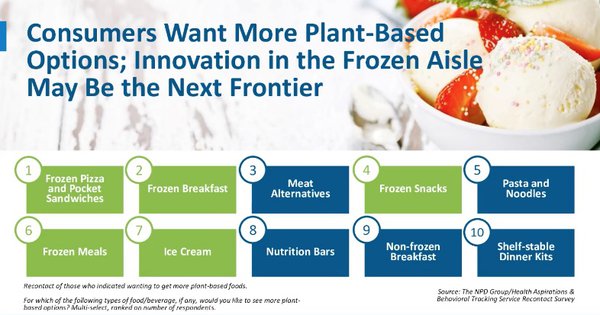
The frozen-food aisle looks to be the
next frontier for innovation in plant-based dairy and meat alternatives.
That’s one of the main takeaways from a recent Food Institute webinar on all things plant-based.
The
overarching message in a presentation by NPD Group executive Darren Seifer: People aren’t necessarily looking to completely replace animal meat and traditional dairy products, but are
open—albeit slowly—to adding plant alternatives to their diet.
“What we eat and drink is very habitual. It’s also culturally based, too,” said Seifer, who is
executive director and industry analyst of food consumption.
Citing consumer data from last year, Seifer noted that plant-based burger alternatives were far and away the biggest category for
at-home consumption—with a 39% share of meat-alternative eating occasions. Next in line were sausage alternatives at 12%.
advertisement
advertisement
In terms of milk alternatives, almond remained king at 72%,
followed by oat at about 8%.
“It’s really still almond and oat that’s taking share from everything else in the plant-based milk market,” Seifer noted.
Only 19%
of consumers surveyed indicated they want more plant-based foods in their diets.
While consumption of animal meats dipped slightly at the beginning of the pandemic, this wasn’t an
indicator of a continued decline. Seifer noted that "consumers are still sticking with what they’ve been doing all along” -- that is, eating meat.
Still, about 15% of consumers
regularly used either a meat or dairy substitute in a given week—representing just over 50 million people “so there’s a pretty substantial market out there.”
Asked
about plant-based desires going forward, five of the top 10 were in frozen foods: pizza and pocket sandwiches (#1), breakfasts (#2), snacks (#4), meals (#6) and ice cream (#7).
“Really,
what they’re trying to say is, how can you conveniently add these items to my diet without me having to do a lot of work,” said Seifer.
The overall drivers of dairy and meat
alternatives continued to be health and wellness reasons—at 56% of consumers for meat, and 51% for dairy. Environmental concerns followed at 40% and 24%, respectively.
But there are vast
generational differences that weigh heavily on how alternatives should be positioned and marketed.
While environment/sustainability topped the concerns of 45% of consumers ages 18-34, it was
31% among those 65+.
The gap widened considerably with regard to concerns about animal welfare. In the 18-34 cohort it was cited by 42%, and by just 8% in the 65+ bracket.
To appeal to
a broad audience, in addition to avoiding the term “vegan,” alternative brands should consider “additional labeling to address health and sustainability concerns.” In addition,
“Carefully consider ingredients when innovating with new products and minimize levels of processing to preserve consumer trust.”
Since millennials and younger generations will
drive the most growth in meat and dairy alternatives going forward, animal welfare and sustainability are key, Seifer noted. “Keep this in mind in messaging, branding, and the entire product
lifecycle of alternatives.”
Data from Tubular Labs—which tracks viewing of video content across Facebook, Instagram, Twitch, Twitter and YouTube, and cross-references it with
behavioral panel data—show which content creators drive the most meat-substitute shoppers to Amazon.
In the last 30 days, meat substitute shoppers on Amazon were 93 times more likely
than the average viewer to come from creator Simnett Nutrition, followed by Avantgardevegan (40x), Sauce Stache (36x), and NYT Cooking (26x).
“Saturday Night Live” social
video audiences were 7 times more likely than the average to shop for Beyond Meat products on Amazon, while NBC News audiences are 5.5x more likely, and CNN audiences, 5.2x.